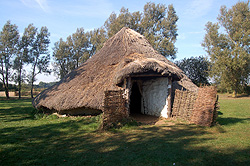Iron Age and Romano-British Clapham

A reconstruction of an Iron Age round house at Flag Fen October 2011
The Bedfordshire Historic Environment Record [HER] contains information on the county’s historic buildings and landscapes and summaries of each entry can now be found online as part of the Heritage Gateway website. A number of sites and finds from both the Iron Age and the Romano-British period have been found in Clapham. In 1946 a small quantity of Iron Age pottery and slag was found east of Clapham Park House; the site is on a promontory and may represent a defended settlement [HER 320]. Iron Age pottery was found in Clapham around the same time [HER 321].
The museum at Saint Ives [Cambridgeshire] has cremated bones, a pair of tweezers and a brooch known as a fibula which were found at Clapham in the early 20th century [HER 9827]. Two late Iron Age gold coins known as staters, probably dating to the period 57-45 BC were found east of Helen’s Wood [HER 15968].
An excavation at Ursula Taylor Lower School ahead of development work in 1987 found evidence of activity in the Mesolithic Period. It also found small, rectangular fields and enclosure ditches running north-west to south-east from the late Iron Age. A roundhouse was also uncovered. Iron Age finds included pottery and a horseshoe which may also be early Romano-British [HER15607].
Archaeological evaluation at Church Farm prior to development on an east-west ridge. An Iron Age rectangular ditched enclosure was found along with animal bones, a nail, a pot and slag, along with animal remains, a finger ring, oyster shells, pottery and tile from the Romano-British period [HER16471].
The Viatores are a group dedicated to discovering Roman roads in the modern landscape. One such proposed road [HER 10480 - Viatores Number 210] is supposed to run from Ickleford [Hertfordshire] to Bedford and beyond, running through Shillington, Henlow, Meppershall, Clifton, Shefford, Campton, Old Warden, Southill, Haynes, Eastcotts, Bedford, Clapham, Oakley, Pavenham, Felmersham, Odell, and Harrold . This road would have run along a footpath between Clapham and Oakley, named Knave’s Bush Way on a map of 1795. Certainly, part of this footpath resembles an agger - remains of a Roman road identified by being a linear formation which is convex in section, just like a modern road, allowing rain to run off to either side into ditches which ran parallel [HER 10459].
In 1853 a lead coffin was reportedly found whilst digging drainage ditches, the exact location now being lost [HER 1318]. It was reported that a gold ring or rings was found in the coffin. A small bronze coin of the Emperor Constantine I (306-337) and minted about 324 was found in the parish [HER 3218]. Two sherds of Roman pottery dating from the late 3rd century was found in the High Street [HER 9855]. It was reported at a meeting of the vestry in 1864 that two Roman silver coins had been found by J W Haddock whilst ploughing [HER 11266]. A sherd from the rim of a Roman pot was found in 1973 [HER 11267].
South of Oakley Road evidence of a significant Iron Age and Romano-British settlement has been found [HER 17184]. Prior to construction of the Clapham Bypass excavations unearthed Iron Age post holes, storage pits, ditches and inclosures as well as an oven, a roundhouse and a trackway. Roman features included a pit and a rectangular enclosure. Finds included Iron Age pottery, slag and animal remains as well as an awl, a nail, a needle, a pin, a quern, a spindle whorl and a whetstone, from the crossover between the Iron Age and Romano-British eras and, from the time of the Roman occupation, a bracelet, a coin, pottery and tiles.